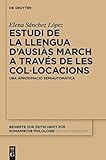Estudi de la llengua d’Ausiàs March a través de les col•locacions : Una aproximació semiautomàtica / Elena Sánchez López.
Material type: TextSeries: Beihefte zur Zeitschrift für romanische Philologie ; 372Publisher: Berlin ; Boston : De Gruyter, [2013]Copyright date: ©2013Description: 1 online resource (178 p.)Content type:
TextSeries: Beihefte zur Zeitschrift für romanische Philologie ; 372Publisher: Berlin ; Boston : De Gruyter, [2013]Copyright date: ©2013Description: 1 online resource (178 p.)Content type: - 9783110275193
- 9783110297690
- 449.90188 22/ger
- online - DeGruyter
- Issued also in print.
| Item type | Current library | Call number | URL | Status | Notes | Barcode | |
|---|---|---|---|---|---|---|---|
 eBook
eBook
|
Biblioteca "Angelicum" Pont. Univ. S.Tommaso d'Aquino Nuvola online | online - DeGruyter (Browse shelf(Opens below)) | Online access | Not for loan (Accesso limitato) | Accesso per gli utenti autorizzati / Access for authorized users | (dgr)9783110297690 |
Diss. Universität Alicante 2010.
Frontmatter -- Índex -- Pròleg -- 1. Introducció -- 2. Marc teòric -- 3. Metodologia -- 4. Estudi preliminar de col·locacions -- 5. Selecció, contextualització i taxonomia de les col·locacions significatives en Ausiàs March -- 6. Conclusions -- 7. Bibliografia -- 8. Índex de Figures -- 9. Índex de mots
restricted access online access with authorization star
http://purl.org/coar/access_right/c_16ec
Des de la primera publicació, el 1593, la bellesa dels versos del poeta valencià Ausiàs March ha representat un repte per als lectors. En aquest estudi hem dut a terme una anàlisi del llenguatge del poeta mitjançant una metodologia innovadora pel que fa a la literatura: l'anàlisi de les combinacions de paraules -col·locacions- amb l'ajuda de les TIC. A partir d'un corpus marcat estructuralment, morfosintàcticament i lematitzat, hem fet una extracció automàtica de les col·locacions de l'obra de March amb l'ajuda d'un motor de cerca optimitzat per a treballar en català antic. Així, tenint en compte les combinacions de categories més freqüents en aquesta llengua, hem obtingut llistats complets de col·locacions -en sentit ampli, com les definia Sinclair en els seus primers treballs-. Posteriorment, hem fet servir un corpus de control per a contextualitzar-les i descriure'n l'ús, cosa que ens ha permés determinar si les combinacions freqüents detectades pertanyien específicament a l'autor -eren part del seu estil-, o a la llengua general de la seua època -com a part de la fraseologia. El nostre estudi ens ha permés constatar les dificultats de l'estudi de la fraseologia en la llengua antiga, així com la productivitat de l'anàlisi col·locacional del llenguatge d'un autor.
Since their first publication in 1593, the complexity and beauty of the verses by Valencian poet Ausiàs March have constituted a challenge for his readers. In this study we present an analysis of the poet’s language using an innovative methodology in the field of literary studies: the analysis of word combinations – collocations – with the support of ICT. Based on a structurally/morphosyntactically-tagged, lemmatized corpus, we carried out an automatic extraction of the collocations in March’s work by means of a search engine optimized to work with the Old Catalan language. Thus, on the basis of the more frequent characteristic patterns of this language, we were able to obtain complete lists of collocations – in a broad sense, as defined by Sinclair in his first research studies. Subsequently, we used a control corpus in order to contextualize them and describe their usage, which allowed us to establish whether the frequent combinations found belong specifically to the author – as an intrinsic part of his style –, or to the general linguistic usage of his age – as part of established Old Catalan phraseology. Our research showed us the difficulties of studying the phraseology of old languages, as well as the productivity of the collocational analysis of an author’s language.
Issued also in print.
Mode of access: Internet via World Wide Web.
In Spanish, Castilian.
Description based on online resource; title from PDF title page (publisher's Web site, viewed 25. Jun 2024)


